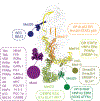Structure of the human Mediator-bound transcription preinitiation complex
- PMID: 33707221
- PMCID: PMC8117670
- DOI: 10.1126/science.abg3074
Structure of the human Mediator-bound transcription preinitiation complex
Abstract
Eukaryotic transcription requires the assembly of a multisubunit preinitiation complex (PIC) composed of RNA polymerase II (Pol II) and the general transcription factors. The coactivator Mediator is recruited by transcription factors, facilitates the assembly of the PIC, and stimulates phosphorylation of the Pol II C-terminal domain (CTD) by the TFIIH subunit CDK7. Here, we present the cryo-electron microscopy structure of the human Mediator-bound PIC at a resolution below 4 angstroms. Transcription factor binding sites within Mediator are primarily flexibly tethered to the tail module. CDK7 is stabilized by multiple contacts with Mediator. Two binding sites exist for the Pol II CTD, one between the head and middle modules of Mediator and the other in the active site of CDK7, providing structural evidence for Pol II CTD phosphorylation within the Mediator-bound PIC.
Copyright © 2021 The Authors, some rights reserved; exclusive licensee American Association for the Advancement of Science. No claim to original U.S. Government Works.
Conflict of interest statement
Figures






References
-
- Thomas MC, Chiang C-M, The general transcription machinery and general cofactors. Critical reviews in biochemistry and molecular biology 41, 105--178 (2006). - PubMed
-
- Soutourina J, Transcription regulation by the Mediator complex. Nature Publishing Group 34, 1--13 (2017).
Publication types
MeSH terms
Substances
Grants and funding
LinkOut - more resources
Full Text Sources
Other Literature Sources
Research Materials

